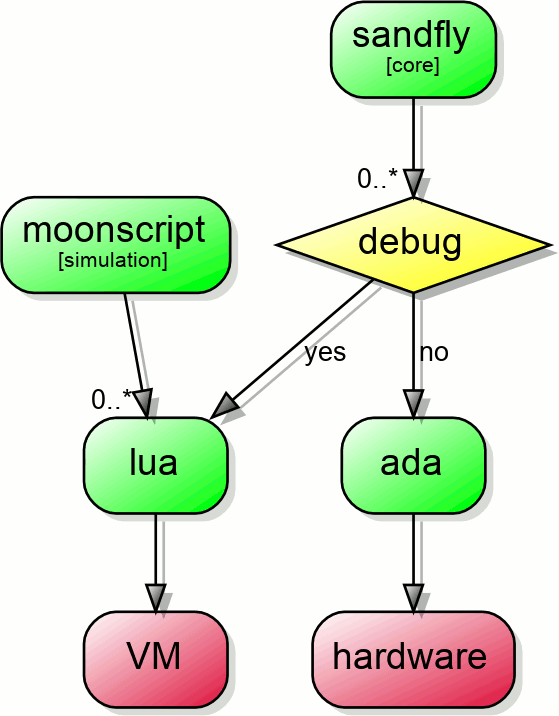Estimated reading time: 4 minutes
Giddy new project love¶
I’ve recently inherited a new tier-one project, which is great news! Sadly, it is in real need of some Tender Loving Care™. Was there ever an inherited project that wasn’t?
The project is our semi-custom transpiler for Ada affectionately called
sandfly. I say semi-custom as it was spun out from a consortium effort to
“facilitate reliability and improve portability” of Ada projects, which is
a far loftier sounding goal than it need be. In essence, it is the
codification of rules and guidelines we’ve adhered to since a partner meeting
in 1996, and that we find ourselves still following today1.
I wasn’t around back when the original group was formed, and it was disbanded
before I’d even heard of Ada. This project is genuinely
multi-generational, which feels nice. All too often our work in software can
feel ephemeral; squeaked on a whiteboard in the morning, tapped in to
a computer in the afternoon and swept away by the janitors as night falls.
Hopes and dreams¶
As the project should have significant longevity I find myself pondering the future. If I could change things for the next 20 years, what should I do to make that experience better? Should I do nothing at all and just chug along reducing the anxiety that even small changes will evoke?
I also find myself pondering the present. Could a truly radical change today obviate the need for this project entirely before the next maintainer grabs the reins for their reign of anxiety? Would that necessarily be a good thing?
Many of the advantages that we associate with Ada — such as its mighty type
safety — no longer feel that advanced or remotely unique. Even “hobby”
languages such as nim implement many of the safety features we expect from
Ada implementations2; subrange types being a fine example where the
nim designers have absorbed an Ada feature. And standard everyday
languages now often have tooling that is capable of providing many of the
benefits of Ada, and one should really only expect this to increase.
What really hammers home the point here is that a good number of the features
one thinks about weren’t even available in Ada when sandfly began; fex
contracts are from Ada 2012. Will languages leapfrog Ada in its niche
by borrowing and then sprint away by innovating as their uptake increases?
Benefits of transpilation¶
The original sandfly authors implemented a transpiler because it made
various checks simpler to carry out. According to the documentation, it was
never intended to become a full blown language in its own right… which of
course it has.
Maybe we should take the opportunity to stay on top of the changing language
landscape thanks to the side effect of sandfly’s implementation details.
Given that we’re already transpiling should we consider alternative targets?
ocaml is the language that immediately jumps to mind, as it is syntactically
close to sandfly and it has an excellent type system. And once you have
ocaml it is a smaller step to F# thanks to its legacy ocaml mode.
The code base is amenable to multiple targets already. A couple of years ago
I implemented support for testing without relying on the support kernel
supplied by our compiler vendor3. At its base sandfly will optionally
generate lua bytecode that is loaded in to a tiny emulator which can be driven
by other lua scripts to test an implementation. Its main purpose was to
allow early experimentation without the expense and time of waiting for
hardware re-fabrication.

As you can see from example usage, it’s source-to-source all the way down.
If I’m writing lua I’m using moonscript, and so should you!¶
I’m not sure it would even be a great stretch to change the main target, there
would likely be significant support for it in fact. It has already been
suggested that we should exclusively switch to spark on a number of occasions,
especially since the reformation in Spark 2014. If we could figure out the
safety certification story I’m sure there would be a lot of traction for F#
as default.
Final thoughts¶
I’ve always really appreciated vala’s alternative syntax support; C# by default, but with first class support for genie’s boo-inspired syntax. I find myself thinking how nice it would be to emulate that and have multiple frontends, and the previously described backends.
In fact I find myself thinking about vala a lot as I write this. It never
had the uptake I would have hoped for when I first read about it. It has
however had a huge impact in the places where it has been used. That surely
makes it a great role model for sandfly going forward. It is better to be
an elusive Aston Martin DB-5 than a common as muck Ford Focus.
So, I’m deep in a pre-reality dream state where I want to add heaps of amazing
new features and functionality, coupled with a cold light of day feeling that
it could be nice to kill the project by transforming it in to a gateway out of
Ada. It could be the best or worst project in the history of the world!
I’m genuinely excited.
Footnotes
- 1
It should be easy to guess why this project is being handed on, given that we’re talking about a twenty-one year old endeavour.
- 2
This isn’t meant to disparage nim, as it is really quite interesting. I mean it purely in the sense that we haven’t yet seen large industry adoption.
- 3
I’m of the strong opinion that vendors who forbid you from naming, shaming and even benchmarking them should be avoided at all costs. However, I’m not on the procurement board and didn’t get to make that decision.
Authenticate this page by pasting this signature into Keybase.
Have a suggestion or see a typo? Edit this page
